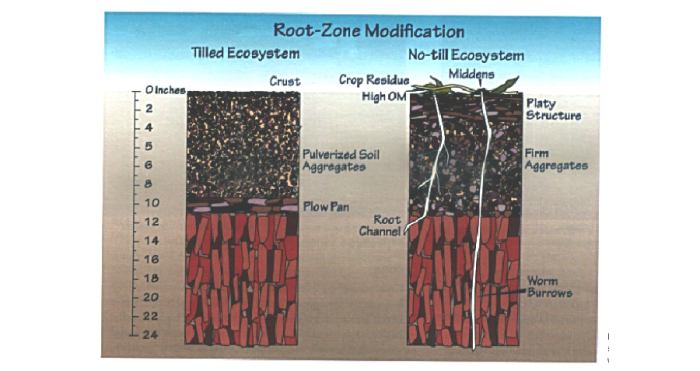Boost Soil Health with No-Till Gardening, Top Benefits Revealed

Benefits of No-Till Gardening for Soil Health
No-till gardening represents a groundbreaking shift in agricultural practices, garnering widespread acclaim in recent years. By eschewing traditional soil disturbance methods like tillage, this approach not only preserves soil health but also enhances fertility and improves structure, ultimately yielding superior crop quality. Let's explore the myriad benefits of adopting no-till gardening practices for maintaining optimal soil health.
The Evolution of No-Till Farming
No-till farming traces its origins back to the 1940s when American farmers began experimenting with leaving crop residues on the soil surface. Initially met with skepticism, these practices soon gained traction as their benefits became apparent. Today, no-till farming has become a global phenomenon, embraced for its role in conserving soil and enhancing agricultural sustainability through conservation tillage methods.
How No-Till Farming Works
No-till farming involves direct planting into untilled soil, avoiding plowing or disruption. Specialized equipment is used for seeding and fertilization, preserving natural soil composition and organic matter crucial for sustained soil health.
Benefits of No-Till Gardening for Soil Health
1. Improved Soil Structure
No-till farming preserves soil structure by maintaining pore space, facilitating enhanced water infiltration and aeration. This fosters improved drainage and robust root growth essential for thriving crops.
2. Increased Organic Matter
By leaving crop residues on the soil surface, no-till farming encourages the gradual decomposition of organic matter. This process enriches the soil with essential nutrients and fosters soil fertility, while also fortifying soil structure by binding soil particles.
3. Enhanced Soil Fertility
No-till practices foster a conducive environment for beneficial soil microorganisms, pivotal in decomposing organic matter and releasing nutrients vital for plant growth. This synergistic relationship enhances overall soil fertility and promotes healthier plant development.
4. Reduced Soil Erosion
The adoption of no-till farming significantly mitigates soil erosion risks by stabilizing soil through the retention of crop residues. This protective layer shields against wind and water erosion, particularly beneficial in vulnerable regions prone to environmental degradation.
5. Conservation of Water
Maintaining undisturbed soil with no-till practices conserves water by minimizing surface evaporation. This retention of moisture optimizes water usage efficiency, ensuring plants have sustained access to hydration critical for growth and resilience.
6. Improved Soil Biota
No-till farming supports a diverse ecosystem of soil organisms such as earthworms, insects, and microorganisms. These inhabitants play pivotal roles in nutrient cycling, organic matter decomposition, and overall soil health improvement, fostering a balanced and sustainable agricultural environment.
The Science Behind No-Till Farming
Scientific research underscores the profound impacts of no-till farming on soil health. Studies by the USDA Natural Resources Conservation Service reveal that no-till practices can elevate soil organic carbon levels by up to 30% compared to conventional tillage methods, indicative of enhanced soil structure and fertility over time.
Practical Applications of No-Till Farming
1. Start Small
Begin by implementing no-till techniques on a smaller scale, such as in garden beds or designated plots. This approach allows for hands-on learning and firsthand observation of the benefits.
2. Use Cover Crops
Integrating cover crops into your farming regimen aids in stabilizing soil structure, erosion control, and organic matter enrichment. These supplementary crops bolster agricultural sustainability and long-term soil health.
3. Choose the Right Equipment
Invest in specialized no-till equipment designed to efficiently plant seeds and nourish soil without disrupting its surface. This strategic investment optimizes farming practices while minimizing environmental impact.
4. Monitor Soil Health
Regularly assess soil health through comprehensive soil testing and analysis. Monitor key indicators such as pH levels, nutrient concentrations, and organic matter content to gauge agricultural productivity and sustainability.
Conclusion
No-till gardening stands as a cornerstone of sustainable agriculture, offering multifaceted benefits that extend beyond crop yields to encompass environmental stewardship and agricultural longevity. By prioritizing soil health through conservation tillage methods and organic matter retention, no-till farming fosters resilient ecosystems and promotes a sustainable food system for future generations.
FAQs
Q: What is no-till farming? A: No-till farming involves planting crops directly into untilled soil, avoiding traditional soil disturbance methods like plowing.
Q: How does no-till farming improve soil health? A: No-till farming enhances soil health by preserving soil structure, increasing organic matter, and promoting beneficial soil microorganisms.
Q: Is no-till farming suitable for all soil types? A: While adaptable to various soils, no-till farming particularly benefits soils with high organic matter and good drainage.
Q: How can I adopt no-till practices in my garden or farm? A: Start by integrating cover crops, using specialized equipment, and monitoring soil health regularly to optimize results.
Q: What challenges are associated with no-till farming? A: Challenges may include initial equipment investment, adaptation to new techniques, and managing weeds and pests effectively.
For more detailed information on soil health and conservation practices, visit the USDA Natural Resources Conservation Service's Soil Health page here.
0 Response to " Boost Soil Health with No-Till Gardening, Top Benefits Revealed"
Post a Comment